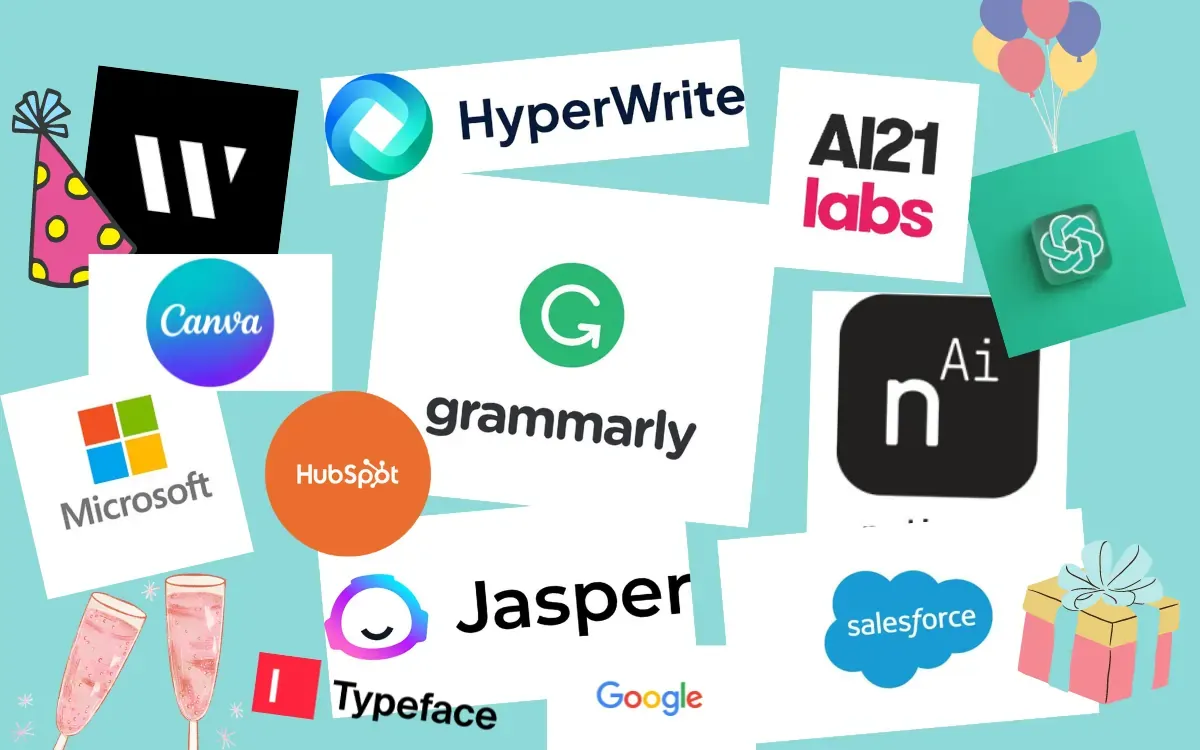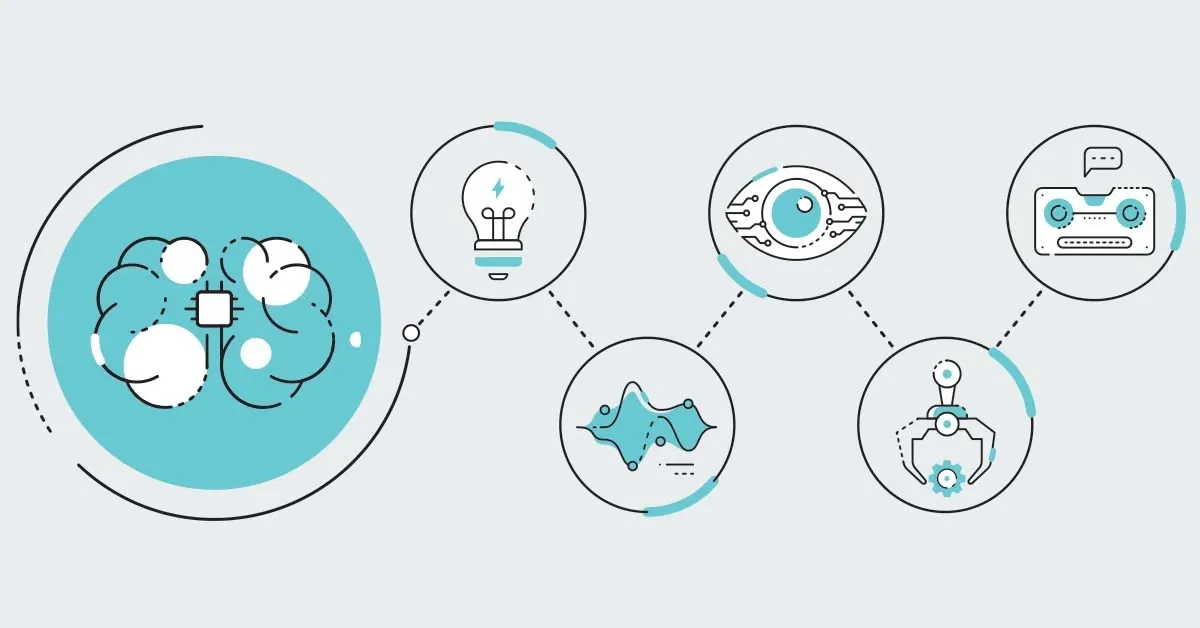No need to look any further if you're after plain, straightforward explanations on generative AI use cases and applications.
We live in a world where AI impacts everything, from art to business strategies. Here, in simple terms, we'll shine a light on how generative AI is changing our reality, creating new things that we hadn’t even imagined before.
Let's strip down the complex layers of tech jargon and focus just on the interesting stuff: real-world applications of generative AI.
Hang tight and expect to uncover mind-blowing instances where AI isn't just mimicking human intelligence but also generating new content. Discover the unexpected and unimaginable ways generative AI is revolutionizing industries and how it can be a game-changer for you.
Now, let's dive in and explore this captivating world of artificial intelligence without any fluff, just facts!
Enterprise Use Cases of Generative AI
Generative AI is transforming the way businesses operate, providing them with innovative solutions for various tasks and challenges.
Let's take a closer look at some of the key use cases in the enterprise world.

Content Generation
Discover the power of generative technologies and how they can streamline news reporting, enhance storytelling and boost social media engagement.
AI algorithms are automating mundane tasks and inspiring novel ideas, allowing businesses and media houses to focus on higher-value work.
Keep reading below to explore these possibilities!
News Articles Automation
Generating news articles is a time-consuming task for journalists. But with generative AI, news agencies can streamline the process and deliver breaking news faster.
AI-powered algorithms can automatically generate news articles based on data and sources, reducing the burden on human writers and ensuring timely news coverage.
Creative Writing and Storytelling
From generating social media captions to crafting engaging narratives, generative AI breathes new life into creative writing and storytelling.
Businesses can use AI algorithms to generate compelling content that resonates with their target audience, saving valuable time and resources.
Social Media Content Creation
Creating eye-catching and engaging social media content is essential for businesses today. Generative AI can assist brands in producing visually appealing graphics, videos, and interactive posts.
With sophisticated algorithms, businesses can enhance their social media presence and captivate their audience.
Suggested Reading:
Reshaping Education: Generative AI in Learning & Development
Image and Video Synthesis
Step inside to learn how generative technologies are change graphic design, virtual experiences, and video production.
Through AI's creative powers, businesses are crafting stunning visuals, enhancing customer interactions, and streamlining content workflows like never before.
Keep reading to uncover these innovations!
Graphic Design and Visual Effects
In graphic design and visual effects, generative AI is a game-changer. AI algorithms can generate stunning visuals, create custom designs, and unleash limitless creativity.
Whether designing logos, producing artwork, or developing brand identities, generative AI empowers businesses to push the boundaries of visual communication.
Product Visualization and Virtual Try-On
Generative AI is revolutionizing the way customers interact with products. Customers can now digitally "try on" clothing, accessories, or even furniture through AI-powered virtual try-on technologies before purchasing.
This enhances the customer experience, reduces return rates, and boosts sales.
Video Editing and Enhancement
Editing videos can be time-consuming, but generative AI can expedite and enhance this task. AI algorithms can analyze, auto-edit, and enhance raw footage, saving editing time while maintaining high-quality visuals.
This leads to more efficient video production and improved storytelling.
Suggested Reading:
Data Augmentation and Synthesis
Generative AI can augment education by synthesizing interactive quizzes, simulations and personalized content for individual students, opening possibilities for personalized learning and improved outcomes.
It also generates synthetic data to train models when real-world data is limited, helping produce accurate models even with scarce data by simulating real scenarios.
This improves both learning materials and model training through data augmentation and synthesis.
Process Optimization and Automation
Generative AI is helping businesses optimize processes, streamline workflows, and make better decisions through data augmentation, synthesis and predictive analytics.
Machine learning algorithms can analyze vast amounts of data to identify patterns and generate new synthetic data, enabling process automation and recommendations.
This allows organizations to streamline operations and workflows for improved efficiency. AI is also revolutionizing predictive maintenance by analyzing sensor data to detect anomalies and predict equipment failures.
By proactively addressing issues, businesses can conduct maintenance efficiently and minimize downtime.
Generative AI in Healthcare

Generative AI has made significant strides in healthcare, revolutionizing various aspects of the industry.
From medical imaging and diagnosis to pharmaceutical research and drug design, generative AI transforms healthcare practices, improves patient outcomes, and drives scientific advancements.
In this section, we'll explore how generative AI positively impacts the healthcare sector.
Medical Imaging and Diagnosis
Generative AI has found its place in medical imaging and diagnosis, providing valuable insights and improving disease detection and prognosis.
Disease Progression Prediction
By analyzing medical images and patient data, generative AI algorithms can predict disease progression, such as cancer or neurodegenerative disorders.
This enables healthcare professionals to devise personalized treatment plans, predict potential complications, and monitor patients' progress more effectively.
Synthetic Medical Image Generation
Generative AI algorithms can generate synthetic medical images that closely resemble real patient data.
This synthetic data can be used to augment training datasets for machine learning models, enhancing their performance and accuracy.
Additionally, synthetic image generation facilitates research and allows medical professionals to conduct experiments without compromising patient privacy.
Pharmaceutical Research and Drug Design
The pharmaceutical research and drug design field is benefiting immensely from generative AI technologies, streamlining the drug development process and enabling personalized medicine.
Accelerating Drug Discovery Process
Generative AI accelerates drug discovery by quickly generating and analyzing vast amounts of chemical and biological data.
These algorithms can predict molecular properties and interactions, leading to identifying potential drug candidates with higher precision and efficiency.
This helps researchers save time and resources while increasing the chances of discovering effective treatments.
Personalized Medicine and Treatment Plans
Generative AI algorithms can analyze patient data, including genetic profiles and medical histories, to create personalized treatment plans.
By leveraging this technology, healthcare providers can optimize medication dosage, predict adverse drug reactions, and develop tailored therapies that target the specific needs of individual patients.
This personalized approach improves treatment outcomes while minimizing side effects.
Generative AI in Manufacturing and Retail
Generative AI is not limited to the healthcare industry; it also makes waves in manufacturing and retail.
Let's look at how generative AI transforms product design, prototyping, and demand forecasting.
Product Design and Prototyping
Generative AI redefines product design and prototyping, providing innovative solutions for creating and visualizing new products.
3D Modeling and Product Visualization
Generative AI algorithms enable designers to create intricate 3D models and visualize product concepts in a virtual environment.
This allows manufacturers to experiment with designs, customize products based on customer preferences, and iterate quickly, saving time and costs associated with physical prototypes.
Customization and Personalization
With generative AI, businesses can offer customized and personalized products to their customers.
By analyzing customer preferences and data, AI algorithms can generate unique variations and configurations, ensuring each customer receives a personalized product. This boosts customer satisfaction and creates a competitive advantage for businesses.
Demand Forecasting and Inventory Management
Generative AI is enhancing forecasting accuracy and optimizing inventory management in the manufacturing and retail sectors.
Predicting Market Trends and Customer Preferences
Generative AI algorithms analyze vast amounts of historical and real-time customer data, providing insights into market trends and consumer preferences.
This enables businesses to accurately forecast demand, optimize production, and align their product offerings with customer expectations.
Improving Inventory Management Efficiency
By implementing generative AI algorithms, businesses can streamline their inventory management processes.
AI-powered models can predict demand fluctuations, recommend optimal inventory levels, and optimize reorder quantities.
This reduces the risk of stockouts or overstocks and improves overall operational efficiency.
In the next section, we will cover the future possibilities and innovations of Generative AI.
Future Possibilities and Innovations

Generative AI constantly evolves, paving the way for remarkable advancements and unlocking new possibilities in various fields.
Let's explore the exciting future of generative AI.
Advancements in Generative AI Technology
As computing power continues to improve, we can expect significant advancements in generative AI technology.
Algorithms will become more sophisticated, generating even more realistic and complex outputs. This will lead to advancements in virtual reality, computer graphics, and content creation.
Researchers are also exploring novel techniques, such as generative adversarial networks (GANs) and reinforcement learning, to push the boundaries of what generative AI can achieve.
These advancements will enable the development of more accurate and robust generative models.
Emerging Use Cases and Industries
Generative AI is finding applications in an ever-expanding range of industries. The potential use cases are vast, from art and entertainment to cybersecurity and finance.
In art, generative AI is used to create unique and thought-provoking artworks, blurring the lines between human and machine creativity.
In cybersecurity, generative AI helps identify and predict potential threats, augmenting human analysts' capabilities.
As technology matures, we can expect generative AI to play a pivotal role in fashion, architecture, and content creation, transforming how we think, design, and innovate.
Potential Impact on the Job Market and Workforce
The rise of generative AI raises concerns about its potential impact on the job market and the workforce.
While AI has historically displaced specific jobs, it has created new opportunities and roles.
Generative AI has the potential to automate specific tasks and processes, increasing efficiency and productivity.
This could lead to job transformations, with human workers focusing on higher-value tasks that require creativity, critical thinking, and emotional intelligence.
To prepare for this future, investing in reskilling and upskilling programs can equip individuals with the necessary skills to thrive alongside generative AI.
It's crucial to foster a collaborative relationship between humans and AI, leveraging the unique strengths of each to drive innovation and progress.
Conclusion
Generative AI is a compelling and transformative technology that revolutionizes industries and pushes the boundaries of what's possible.
While it presents challenges regarding bias, privacy, and its impact on jobs, addressing these issues proactively through fairness training, privacy-preserving methods, and reskilling can help maximize its benefits.
By fostering collaboration between humans and AI, we can leverage each of their strengths to drive innovation and progress.
The future possibilities of generative AI seem endless as it unlocks new applications and uses cases across diverse fields.
With responsible development and oversight, it has the potential to uplift humanity by automating mundane tasks and freeing up human creativity to solve our world's greatest challenges. The most exciting innovations may be yet to come.
By crafting ready-to-deploy AI chatbot solutions for multiple platforms, BotPenguin makes sure that your business reaches wherever your customers are:

Frequently Asked Questions (FAQs)
What is the most used generative AI in the market?
OpenAI's GPT-3 is among the most widely used generative AI models, renowned for its natural language processing capabilities, enabling tasks like language translation, content generation, and even coding assistance.
What is generative AI good for in business?
Generative AI proves beneficial in automating content creation, aiding in product design iterations, facilitating personalized marketing strategies, and enhancing customer engagement through chatbots, thereby streamlining operations and driving business growth.
What is an example of a generative AI application?
One prominent example is DALL-E, an AI model by OpenAI that generates images from textual descriptions, demonstrating the potential of generative AI in creating custom visual content, revolutionizing the creative process for artists, designers, and illustrators.
What are some prominent applications of generative AI in healthcare?
Generative AI aids in medical image generation, drug discovery, and the creation of synthetic patient data, facilitating research, diagnosis, and treatment planning.



